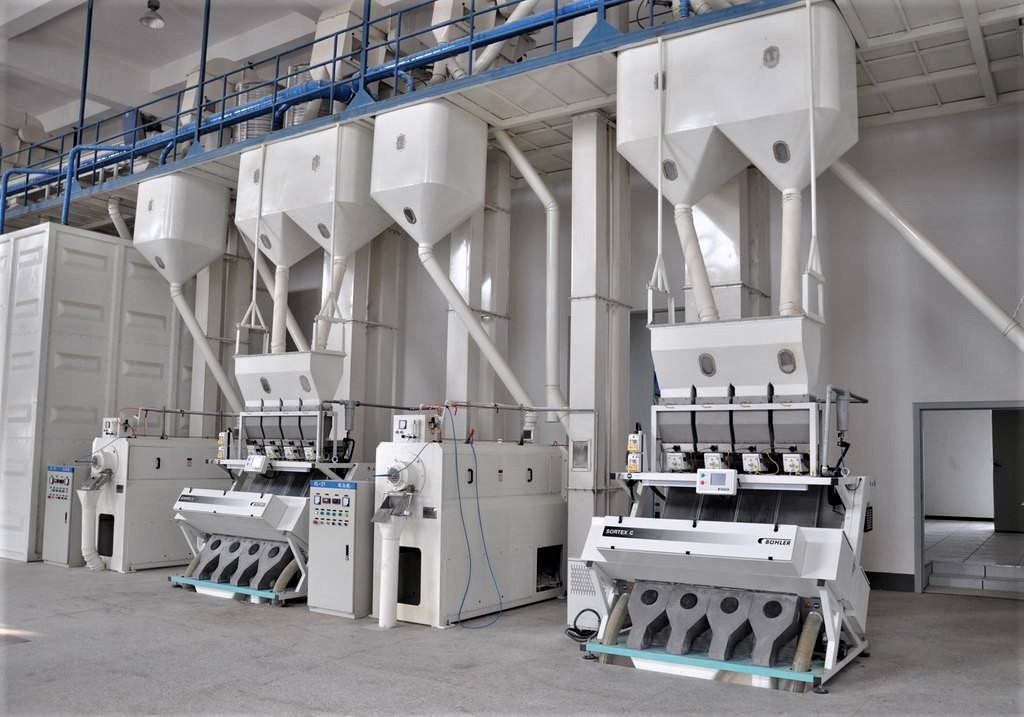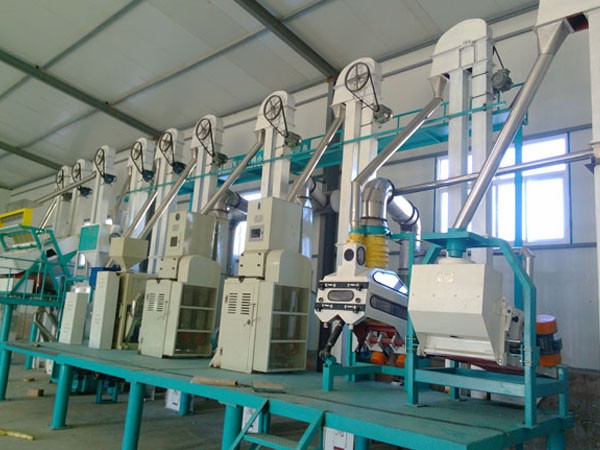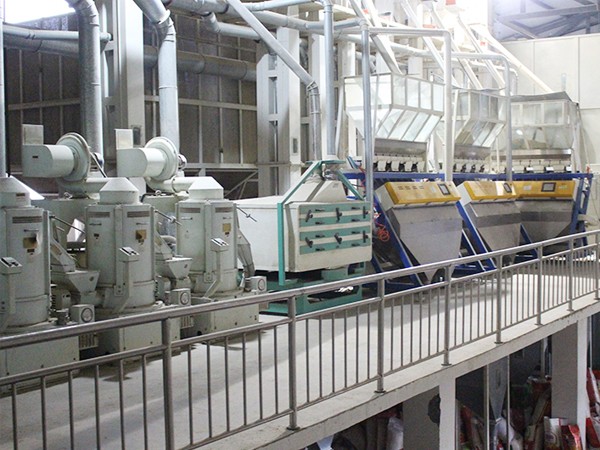1. Premium rice
Special grade rice is a kind of rice product that is refined by using high-quality rice. The processing accuracy is 1-2 grades higher than ordinary rice, and the impurities and broken rice are less than ordinary rice. In the past, special-grade rice was mainly sold abroad in the past. At present, domestic sales are developing rapidly, and the market demand continues to increase. The processing technology and equipment requirements of special-grade rice are relatively high. In addition to the addition of impurities and sand removal, grain separation, and rice classification, the processing is mainly carried out by the advanced technology of "multi-machine light grinding to produce white". In recent years, on the basis of introducing, digesting and absorbing foreign advanced technology, my country’s grain machinery industry has developed a domestically produced special rice processing production line. A considerable part of its technology and equipment has reached the international advanced level, laying a foundation for the rapid development of my country’s special rice production. basis.
2.Disposable rice
Wash-free rice is also called clean rice (including water milled rice in a broad sense), which is characterized by minimal impurities, smooth surface, clean and hygienic, and anti-pollution and quality-preserving packaging. The processing standards for such products must basically meet the "four breaks", that is, broken sand, broken grain, broken barnyard, and broken chaff. It also needs to be processed and packaged in an environment free of sanitary pollution, and there is no sanitary pollution of rice grains during the shelf life. Guarantee measures. The product is storage-resistant, and can be directly cooked in the pot without washing during consumption, thus avoiding the loss of nutrients and solids during the washing process of rice, and also saving the water for washing rice. The key to the technology of processing non-washing rice is to remove impurities, remove chaff, select and clean. It requires corresponding high-standard impurity removal equipment and technology, rice brushing technology and equipment (such as white rice polishing machine, etc.), and white rice selection equipment (such as computers). Color sorter, etc.). At present, most of the rice supplied in the markets of Japan, the United States, Italy, Australia and other countries are disposable rice. However, due to poor processing conditions in my country, it is rare to see real disposable rice on the market.

3.Parboiled rice
Parboiled rice is also called half-boiled rice. The basic processing procedure is the same as that of ordinary rice, except that the hydrothermal treatment process of soaking, cooking and drying the pure grain is added before the hulling. After hydrothermal treatment of rice, the strength of rice grains is increased, the process quality is improved, and the rate of broken rice is reduced. At the same time, during the process of hydrothermal treatment, the nutrients such as vitamins and minerals in the cortex of the rice penetrate into the interior of the rice, so that the nutrients in the endosperm increase. Improve the nutritional value of rice; in addition, parboiled rice has the advantages of storability, good rice swelling, high rice yield, and easy digestion of rice. Therefore, 1/5 of the rice in the world is processed into parboiled rice every year. Countries such as India, Thailand, and Somalia are the main producers of parboiled rice. Countries such as the United States and Italy also produce it, mainly to improve the nutritional value and Processing quality. Farmers in Zhejiang, Fujian, Guangdong and other places in my country also have a long history of producing parboiled rice. In the 1960s, a certain scale of parboiled rice production plants were established in Jiangsu and Zhejiang. Their products are mainly exported to Arab countries in the Middle East. Grain rice penetrates the color of the rice skin, unlike ordinary white rice with a white appearance, so the domestic sales volume is not large.
4.Germ rice
Germ rice refers to a kind of rice product in which the rice germ of polished rice is retained. It is also called germ rice, and the germ retention rate should be above 80%. Because rice germ contains vitamin E, B1, B2 and other rich nutrients such as high-quality protein and fat, the nutritional value of germ rice is higher than that of ordinary rice. In ordinary rice processing, most of the embryos of brown rice will fall off during the whitening and peeling process, so ordinary rice basically does not leave embryos. The processing of germ rice requires special processing technology and equipment. Brown rice needs to be pretreated with chemical solvents or enzymes before whitening and peeling to make the rice skin loose and soft. Grind under low pressure impact state, remove the rice skin and keep the germ. Germ rice first came out in Japan in 1924 and played a certain role in the prevention of beriberi that was prevalent in Japan at that time. In 1977, the Japanese government officially designated germ rice as a rice product. At present, there is no germ rice on the market in my country, and it is rare in other countries. The main reason is that the storability of germ rice has not been solved well. In addition, the rice germ has a special taste and the taste is not good when eaten. It has not been accepted by consumers.

5. Nutritional fortified rice
Nutrition-fortified rice refers to rice that has been added with certain nutrients needed by the human body. Because the cortex and germ containing a variety of nutrients are crushed during the processing of high-grade rice to improve the precision and improve the palatability, its nutritional value is seriously reduced. In order to make people eat delicious and palatable rice while also getting enough The problem of nutrition fortification of rice has aroused the attention of health and nutrition departments in various countries. The research on rice nutrition fortification technology is being carried out in depth. The United States, Japan and other countries researched earlier, proposed a variety of fortification techniques, also produced a variety of nutrition fortification rice products, and formulated the nutrition fortification standards of rice in law.
The processing technology of nutritionally fortified rice is mainly divided into two categories: (1) Internal holding method. That is, try to preserve the vitamins, mineral salts and other nutrients contained in the outer layer of the rice grains or germ. my country's traditional parboiled rice and the above-mentioned germ rice also belong to this form of nutritionally fortified rice. (2) Additive method. That is, various nutrients are distributed into a stable aqueous or oily solution, which is attached to the rice grains by soaking or spraying. The types of nutrient fortifiers are different, and the varieties of nutritious rice are also different. There are vitamin B1 and B2 fortified rice, thiamine, riboflavin, niacin, iron, calcium, vitamin D fortified rice, and amino acid, vitamin, and mineral salt fortified rice. Wait. There are concentrated types of products, which are mixed with ordinary polished rice at a ratio of 1:100 or 1:200 for cooking; there are ordinary types, which can be cooked directly without mixing; there are also powder-mixed and artificial rice to add nutrients The powder is mixed into rice or made into rice-like particles and then mixed into rice medium in proportion.
Our country’s nutritionally fortified rice is still in the development stage. Wuxi Institute of Light Industry has developed a simple and practical strong nutritional fortification process and equipment, and it is effective in the formulation of fortified rice nutrients, the preservation rate of nutrients and the effectiveness of the formula, The effects of rice quality and flavor have been studied in depth, which provides a theoretical basis for the production of nutritionally fortified rice.
6.Instant rice
Instant rice is also called fast food rice or a rice. It is made by using different pretreatment techniques to process rice grains. It only needs to be cooked or soaked in hot water for a few minutes to eat, and some can be eaten directly. The product forms include quick-cooked rice, instant rice, flavored instant rice and so on. The production process is mainly to use methods such as freezing, puffing, pre-cooking, roasting and other methods to ablize the starch of rice grains and maintain a proper degree, so that the rice grains become rice state or uniform porous body. Foreign countries have relatively mature technology for the production of instant rice, especially in Japan and the United States, where multiple patented technologies appear every year. The annual output of quick-cooked rice in Japan is more than 280,000 tons, and the annual sales volume is more than 90 million copies. 71% of the edible rice in the United States is used for processing quick-cooked rice. In recent years, the development and production of quick-cooked rice in various parts of my country has developed rapidly. Many instant rice production lines have been put into production in Guangzhou, Beijing, Jinan and other places. However, due to rough technology, backward technology, and high prices, sales are not satisfactory.

7. Quick-cooked brown rice and brown rice flour
Quick-cooked brown rice is a new type of deep-processed rice product that integrates nutritious rice, germ rice and instant rice, with more natural health functions. Although brown rice is good for health, it is difficult to cook, difficult to eat, hard skin and has peculiar smell. Most people do not like to eat it. It is especially necessary to improve the palatability of brown rice. The U.S. and Japan have carried out research on quick-cooked brown rice for many years, and several products have appeared on the market. The more mature product is canned brown rice in Japan. Malaysia and other countries grind brown rice into powder after pretreatment, and use it as a nutrient additive or health food after preparation. my country's brown rice food is mostly limited to black rice, such as processing black brown rice into black rice paste.
8. Rice products
Rice products mainly refer to foods developed with rice as the main raw material. For example, rice vermicelli, rice cakes, rice noodles (such as shahe noodles), rice wine, etc. are traditional products that are well-known in my country. In the past 10 years, the development of rice products is moving towards easy-to-eat, delicious, health-care and other aspects. For example, the traditional rice vermicelli (beta) process is changed to the α-drying method to make instant rice noodles; rice or rice noodles are combined with others. The materials are made into rice noodles with appropriate techniques and formulas, such as nutritious rice noodles, high-protein rice noodles, etc.; rice cakes (slices) produced by baking or puffing technology. This kind of food is popular because of its easy preparation, variety, and health function.
The above is the deep processing technology shared by Henan Zhongxing Grain and Oil Machinery.
Copyright © Henan Zhongxing Grain And Oil Machinery Co.,Ltd. All Rights Reserved. Powered by MetInfo